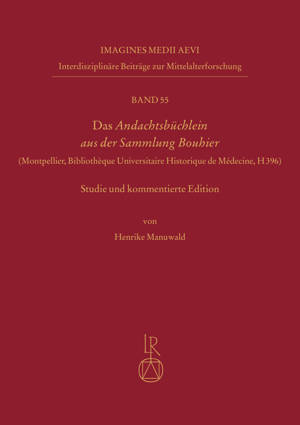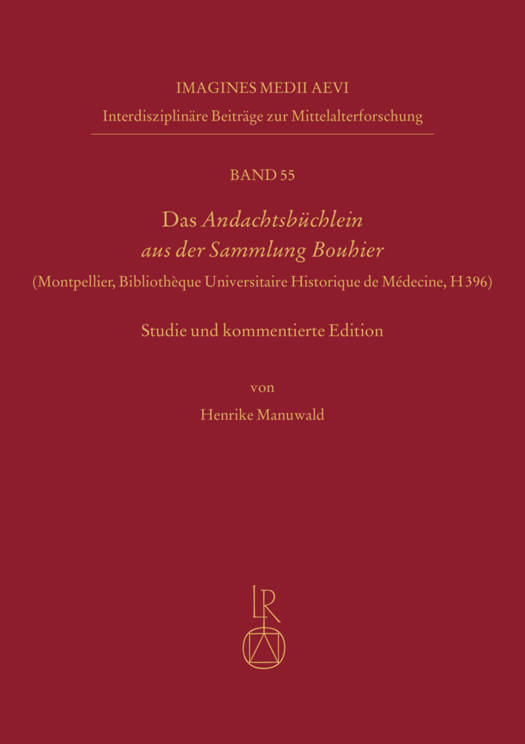
En raison d'une grêve chez bpost, votre commande pourrait être retardée. Vous avez besoin d’un livre rapidement ? Nos magasins vous accueillent à bras ouverts !
- Retrait gratuit dans votre magasin Club
- 7.000.000 titres dans notre catalogue
- Payer en toute sécurité
- Toujours un magasin près de chez vous
En raison de la grêve chez bpost, votre commande pourrait être retardée. Vous avez besoin d’un livre rapidement ? Nos magasins vous accueillent à bras ouverts !
- Retrait gratuit dans votre magasin Club
- 7.000.0000 titres dans notre catalogue
- Payer en toute sécurité
- Toujours un magasin près de chez vous
Das Andachtsbuchlein Aus Der Sammlung Bouhier
Henrike Manuwald
Livre relié | Allemand | Imagines Medii Aevi. Interdisziplinäre Beiträge zur Mittelalterforschung | n° 55
144,45 €
+ 288 points
Description
English summary: In the seventeenth century a small-size parchment manuscript with German text, illustrated throughout with coloured pen-and-ink-drawings, entered the book collection of the Bouhier family in Dijon. This manuscript (of which 48 folios are still extant), presumably produced in the second quarter of the fourteenth century in eastern central Germany, is without parallel with regard to its structure: A first part (not completely preserved) displays on each page an image relating to a gospel pericope; above the image a German text indicates the occasion for the reading, followed by a partial paraphrase of the content of the pericope, sometimes breaking off in the middle of a sentence. This section is followed by a festival calendar with pictorial abbreviations. The sequence closes with a passion cycle without any textual elements. The provenance of this unique manuscript cannot be traced back beyond its cataloguing in Dijon; information about its origin and the context for its use can only be inferred from the object itself. This publication presents the first edition and detailed study of this manuscript, including a determination of its function ('Andachtsbuchlein' - 'devotional booklet') and the evaluation of its role within the history of piety. Among other aspects, the analysis covers codicological and palaeographical questions, the liturgical context, the structure of the text and the iconography. The findings are contextualized and set in a larger frameworks, such as the increasing spread of German-language pericopes in the late Middle Ages. The accompanying edition offering a complete reproduction of all pages of the manuscript in colour with adjacent commentary enables the immediate verification of the individual observations. In the context of German studies the exploration of the manuscript text leads to new insights, since it expands the existing picture of how pericopes in German language were dealt with. The fact that the paraphrases regularly break off enables conclusions on techniques of reception as well as the educational preconditions. In terms of art history the analysis of the manuscript contributes an important building block to the yet-to-be-written history of illustrated cycles of pericopes. Moreover, the manuscript displays iconographically rare motifs, for instance in the calendar, whose type is not attested elsewhere in German-speaking countries as part of a book. In particular, the manuscript conveys insights into elements of the history of piety: already in its original form it displays links to liturgical frameworks, especially Dominican liturgy, as well as to folk traditions. Additions of images and texts in the calendar, extending until the early sixteenth century, document a continuous intensive use, for example in a Carthusian context as well as in connection with the veneration of saints as helpers in need. Accordingly, the manuscript points to interactions between different religious spheres, as they will have to discussed further for the religious history of the late Middle Ages. German description: Im 17. Jahrhundert fand eine kleinformatige, durchgehend mit kolorierten Federzeichnungen ausgestattete Pergamenthandschrift mit deutschsprachigem Text Eingang in die Buchersammlung der Familie Bouhier in Dijon. Die heute noch 48 Blatter umfassende Handschrift, wohl im zweiten Viertel des 14. Jahrhunderts im ostmitteldeutschen Raum entstanden, ist in ihrer Anlage ohne bekannte Parallele: Ein erster Teil (nicht vollstandig erhalten) bietet auf jeder Seite ein Bildfeld zu einer Evangelienperikope; daruber ist in deutscher Sprache jeweils der Leseanlass angegeben, gefolgt von einer Teilparaphase des Perikopeninhalts, die nicht selten mitten im Satz abbricht. An den Perikopenteil schliesst sich ein Festkalender mit Bildkurzeln an. Beschlossen wird die Handschrift von einem textlosen Passionsbilderzyklus. Die Provenienz dieser einzigartigen Handschrift lasst sich nicht uber ihre Katalogisierung in Dijon zuruckverfolgen; Indizien uber Herkunft und Gebrauchskontexte konnen nur aus dem Objekt selbst gewonnen werden. In der vorliegenden Publikation wird die Handschrift erstmals ediert und im Detail erschlossen, in ihrer Funktion bestimmt (, Andachtsbuchlein') und frommigkeitsgeschichtlich ausgewertet. Sie wird u.a. im Hinblick auf kodikologische und palaographische Fragen, die liturgischen Bezugssysteme, die Textstruktur und die Ikonographie eingehend analysiert. Die Befunde sind jeweils kontextualisiert und in grossere Zusammenhange eingeordnet, etwa die zunehmende Verbreitung deutschsprachiger Perikopen im Spatmittelalter. Im Editionsteil erlaubt die vollstandige farbige Reproduktion der Handschrift mit Erlauterungen direkt daneben einen unmittelbaren Nachvollzug der Einzelbeobachtungen. Aus germanistischer Perspektive bietet allein schon die Erschliessung des Textbestandes der Handschrift neue Erkenntnisse, weil sie das bisherige Bild von dem Umgang mit Perikopen in deutscher Sprache erweitert. Die abbrechenden Paraphrasen lassen ausserdem Ruckschlusse auf Rezeptionstechniken und die bildungsgeschichtlichen Voraussetzungen dafur zu. In kunsthistorischer Hinsicht bildet die Analyse der Handschrift einen wichtigen Baustein in der noch zu schreibenden Geschichte von Perikopen-Bilderzyklen. Hinzu kommen ikonographisch seltene Motive, auch im Kalenderteil, dessen Typus fur den deutschen Sprachraum in Buchform sonst nicht belegt ist. Vor allem sind aus der Handschrift Einblicke in Frommigkeitspraktiken zu gewinnen: Schon in der ursprunglichen Schicht zeigt sie sowohl Bezuge zu liturgischen Ordnungen, insbesondere der dominikanischen Liturgie, als auch zum Brauchtum. Bildliche und schriftliche Nachtrage im Kalenderteil aus der Zeit bis zum fruhen 16. Jahrhundert dokumentieren eine anhaltende intensive Nutzung u.a. im kartausischen Kontext und im Kontext der Verehrung von Heiligen als Nothelfern. Insofern verweist die Handschrift auf eine Durchdringung verschiedener religioser Spharen, wie sie fur die Frommigkeitsgeschichte des Spatmittelalters weiter zu diskutieren sein wird.
Spécifications
Parties prenantes
- Auteur(s) :
- Editeur:
Contenu
- Nombre de pages :
- 550
- Langue:
- Allemand
- Collection :
- Tome:
- n° 55
Caractéristiques
- EAN:
- 9783752006568
- Date de parution :
- 01-09-22
- Format:
- Livre relié
- Format numérique:
- Genaaid
- Dimensions :
- 176 mm x 40 mm
- Poids :
- 17998 g

Les avis
Nous publions uniquement les avis qui respectent les conditions requises. Consultez nos conditions pour les avis.






